OPEL MOVANO_B 2020 Owner's Manual
Manufacturer: OPEL, Model Year: 2020, Model line: MOVANO_B, Model: OPEL MOVANO_B 2020Pages: 353, PDF Size: 9.4 MB
Page 261 of 353
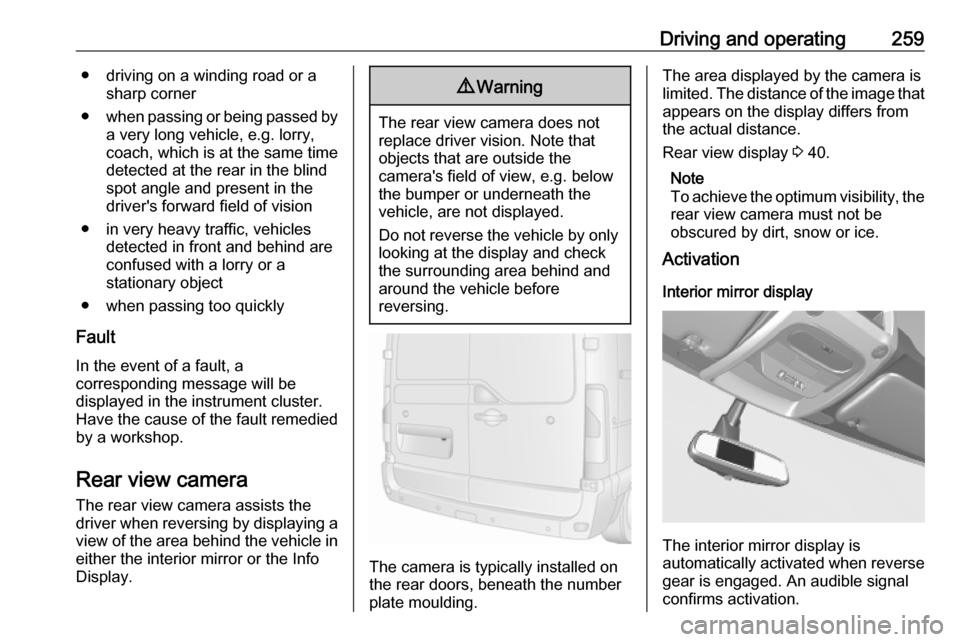
Driving and operating259● driving on a winding road or asharp corner
● when passing or being passed by
a very long vehicle, e.g. lorry,
coach, which is at the same time
detected at the rear in the blind spot angle and present in the
driver's forward field of vision
● in very heavy traffic, vehicles detected in front and behind are
confused with a lorry or a
stationary object
● when passing too quickly
Fault
In the event of a fault, a
corresponding message will be
displayed in the instrument cluster.
Have the cause of the fault remedied
by a workshop.
Rear view camera The rear view camera assists the
driver when reversing by displaying a view of the area behind the vehicle in
either the interior mirror or the Info
Display.9 Warning
The rear view camera does not
replace driver vision. Note that
objects that are outside the
camera's field of view, e.g. below
the bumper or underneath the
vehicle, are not displayed.
Do not reverse the vehicle by only looking at the display and checkthe surrounding area behind and
around the vehicle before
reversing.
The camera is typically installed on
the rear doors, beneath the number
plate moulding.
The area displayed by the camera is
limited. The distance of the image that
appears on the display differs from
the actual distance.
Rear view display 3 40.
Note
To achieve the optimum visibility, the rear view camera must not be
obscured by dirt, snow or ice.
Activation
Interior mirror display
The interior mirror display is
automatically activated when reverse
gear is engaged. An audible signal
confirms activation.
Page 262 of 353
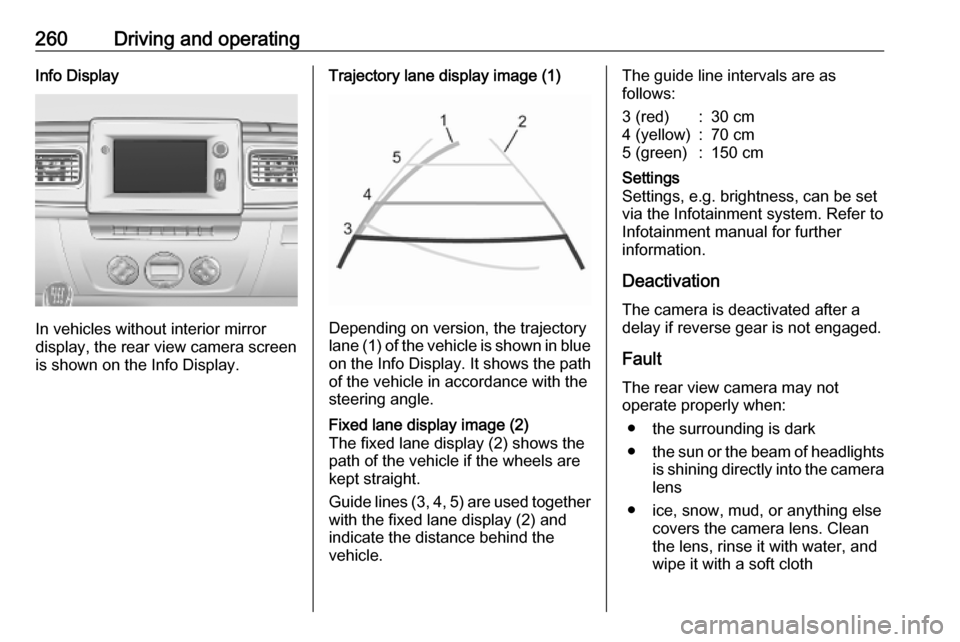
260Driving and operatingInfo Display
In vehicles without interior mirror
display, the rear view camera screen
is shown on the Info Display.
Trajectory lane display image (1)
Depending on version, the trajectory
lane (1) of the vehicle is shown in blue
on the Info Display. It shows the path of the vehicle in accordance with the
steering angle.
Fixed lane display image (2)
The fixed lane display (2) shows the
path of the vehicle if the wheels are
kept straight.
Guide lines (3, 4, 5) are used together
with the fixed lane display (2) and
indicate the distance behind the
vehicle.The guide line intervals are as
follows:3 (red):30 cm4 (yellow):70 cm5 (green):150 cmSettings
Settings, e.g. brightness, can be set
via the Infotainment system. Refer to
Infotainment manual for further
information.
Deactivation
The camera is deactivated after a
delay if reverse gear is not engaged.
Fault
The rear view camera may not
operate properly when:
● the surrounding is dark
● the sun or the beam of headlights
is shining directly into the camera lens
● ice, snow, mud, or anything else covers the camera lens. Clean
the lens, rinse it with water, and
wipe it with a soft cloth
Page 263 of 353
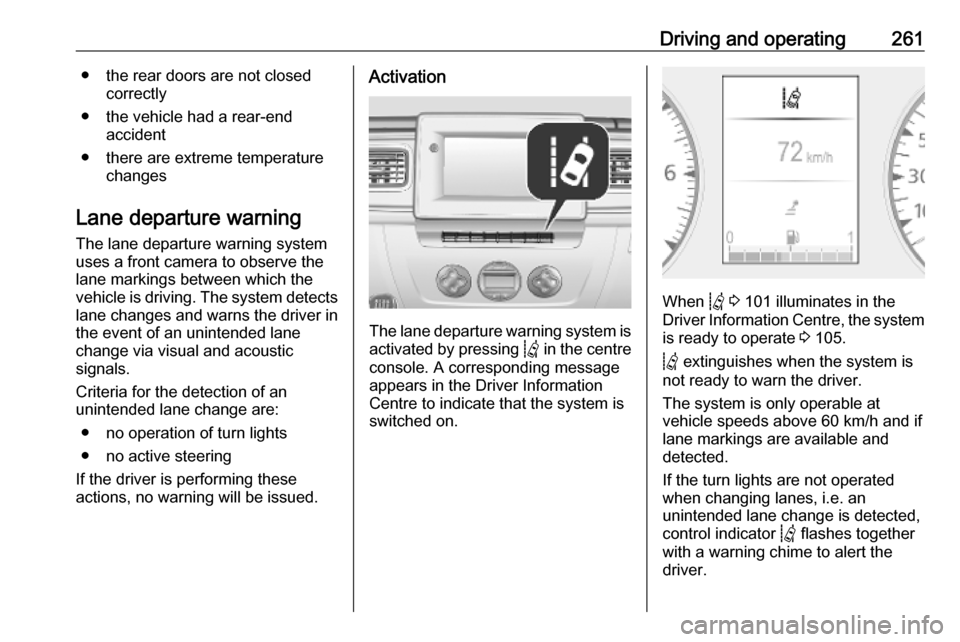
Driving and operating261● the rear doors are not closedcorrectly
● the vehicle had a rear-end accident
● there are extreme temperature changes
Lane departure warning The lane departure warning system
uses a front camera to observe the
lane markings between which the
vehicle is driving. The system detects
lane changes and warns the driver in
the event of an unintended lane
change via visual and acoustic
signals.
Criteria for the detection of an
unintended lane change are:
● no operation of turn lights
● no active steering
If the driver is performing these
actions, no warning will be issued.Activation
The lane departure warning system is activated by pressing Q in the centre
console. A corresponding message
appears in the Driver Information
Centre to indicate that the system is
switched on.
When Q 3 101 illuminates in the
Driver Information Centre, the system is ready to operate 3 105.
Q extinguishes when the system is
not ready to warn the driver.
The system is only operable at
vehicle speeds above 60 km/h and if
lane markings are available and
detected.
If the turn lights are not operated
when changing lanes, i.e. an
unintended lane change is detected,
control indicator Q flashes together
with a warning chime to alert the
driver.
Page 264 of 353

262Driving and operatingDeactivation
The system is deactivated by
pressing Q. A corresponding
message appears in the Driver
Information Centre to indicate that the
system is switched off.
At speeds below 60 km/h the system is inoperable.
Operation hints
The lane departure warning system
may not operate properly when:
● The windscreen is not clean.● There are adverse environmental
conditions like heavy rain, snow,
direct sunlight or shadows.
● Lane departure is very fast.
● Acceleration is very strong.
● Bends are tight.
● Driving continuously on a line.
The system cannot operate when no
lane marking is detected.Fault
In the event of a fault in the system, a warning message appears in the
Driver Information Centre (possibly in
combination with control indicator
j ).
Seek the assistance of a workshop.
Driver Information Centre 3 105.Fuel
Fuel for diesel engines The Diesel engines are compatible
with bio-fuels that conform to current and future European standards and
can be obtained from filling stations:
Diesel fuel that meets standard
EN590 mixed with a biofuel that
meets standard EN14214 (possibly
containing up to 7% Fatty Acid Methyl
Ester).
Page 265 of 353
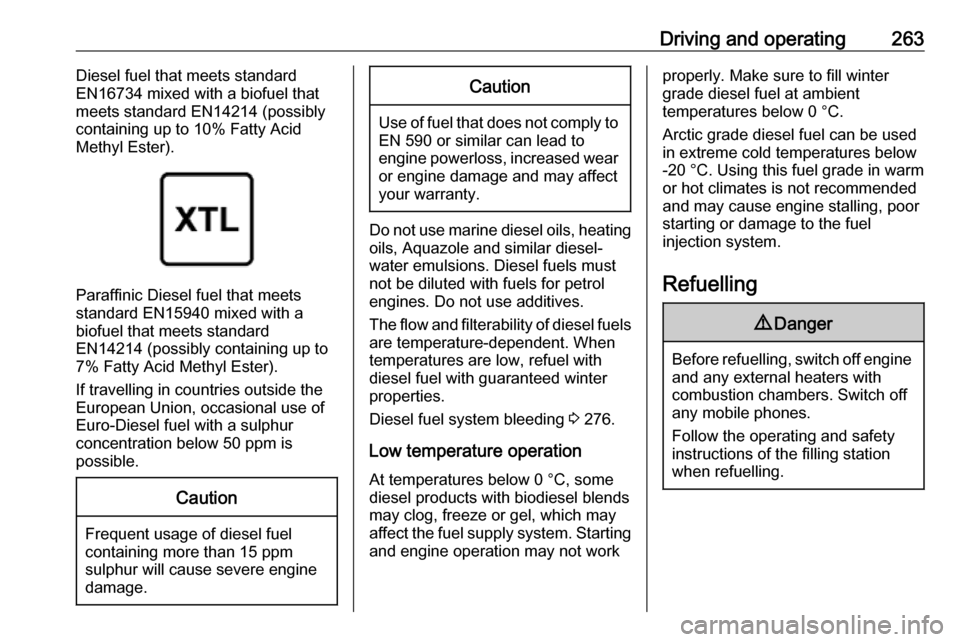
Driving and operating263Diesel fuel that meets standard
EN16734 mixed with a biofuel that
meets standard EN14214 (possibly
containing up to 10% Fatty Acid
Methyl Ester).
Paraffinic Diesel fuel that meets
standard EN15940 mixed with a
biofuel that meets standard
EN14214 (possibly containing up to
7% Fatty Acid Methyl Ester).
If travelling in countries outside the
European Union, occasional use of Euro-Diesel fuel with a sulphur
concentration below 50 ppm is
possible.
Caution
Frequent usage of diesel fuel containing more than 15 ppm
sulphur will cause severe engine
damage.
Caution
Use of fuel that does not comply to EN 590 or similar can lead to
engine powerloss, increased wear
or engine damage and may affect
your warranty.
Do not use marine diesel oils, heating
oils, Aquazole and similar diesel-
water emulsions. Diesel fuels must
not be diluted with fuels for petrol
engines. Do not use additives.
The flow and filterability of diesel fuels are temperature-dependent. When
temperatures are low, refuel with
diesel fuel with guaranteed winter
properties.
Diesel fuel system bleeding 3 276.
Low temperature operation
At temperatures below 0 °C, some
diesel products with biodiesel blends
may clog, freeze or gel, which may
affect the fuel supply system. Starting
and engine operation may not work
properly. Make sure to fill winter
grade diesel fuel at ambient
temperatures below 0 °C.
Arctic grade diesel fuel can be used
in extreme cold temperatures below
-20 °C. Using this fuel grade in warm
or hot climates is not recommended
and may cause engine stalling, poor starting or damage to the fuel
injection system.
Refuelling9 Danger
Before refuelling, switch off engine
and any external heaters with
combustion chambers. Switch off
any mobile phones.
Follow the operating and safety
instructions of the filling station
when refuelling.
Page 266 of 353
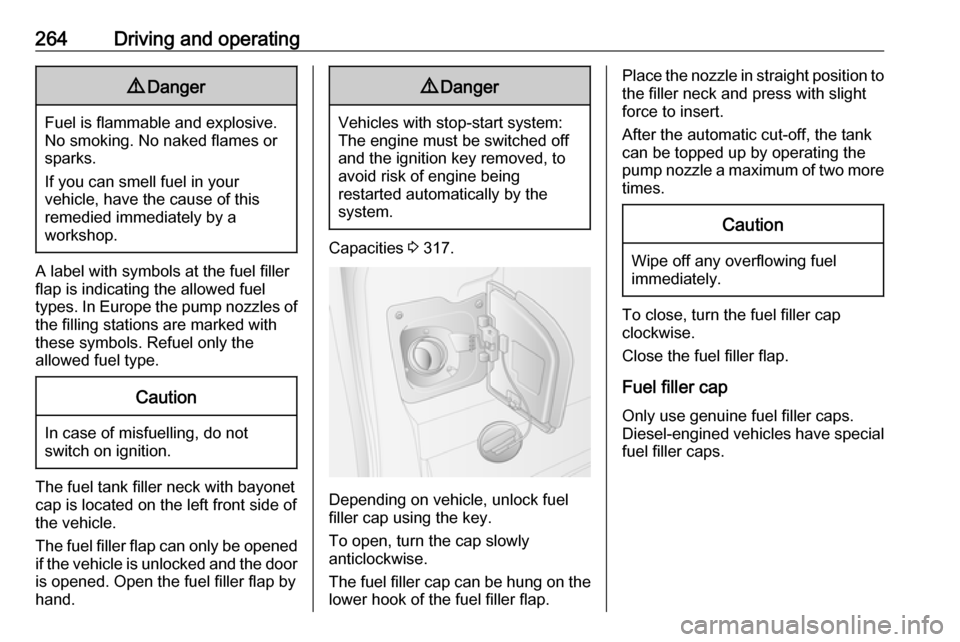
264Driving and operating9Danger
Fuel is flammable and explosive.
No smoking. No naked flames or
sparks.
If you can smell fuel in your
vehicle, have the cause of this
remedied immediately by a
workshop.
A label with symbols at the fuel filler
flap is indicating the allowed fuel
types. In Europe the pump nozzles of the filling stations are marked with
these symbols. Refuel only the
allowed fuel type.
Caution
In case of misfuelling, do not
switch on ignition.
The fuel tank filler neck with bayonet
cap is located on the left front side of
the vehicle.
The fuel filler flap can only be opened
if the vehicle is unlocked and the door is opened. Open the fuel filler flap by
hand.
9 Danger
Vehicles with stop-start system:
The engine must be switched off
and the ignition key removed, to
avoid risk of engine being
restarted automatically by the
system.
Capacities 3 317.
Depending on vehicle, unlock fuel
filler cap using the key.
To open, turn the cap slowly
anticlockwise.
The fuel filler cap can be hung on the lower hook of the fuel filler flap.
Place the nozzle in straight position to
the filler neck and press with slight
force to insert.
After the automatic cut-off, the tank
can be topped up by operating the
pump nozzle a maximum of two more times.Caution
Wipe off any overflowing fuel
immediately.
To close, turn the fuel filler cap
clockwise.
Close the fuel filler flap.
Fuel filler cap Only use genuine fuel filler caps.Diesel-engined vehicles have special
fuel filler caps.
Page 267 of 353

Driving and operating265Trailer hitch
General information
Only use towing equipment that has
been approved for your vehicle.
Entrust fitting of towing equipment at
a later date to a workshop. It may be
necessary to make changes that
affect the cooling system, heat
shields or other equipment.
Driving characteristics and towing tips
In the case of trailers with brakes,
attach the breakaway stopping cable.
Before attaching a trailer, lubricate
the coupling ball. However, do not do
so if a stabiliser, which acts on the coupling ball, is being used to reduce
snaking movements. For trailers with
low driving stability the use of a
stabiliser is recommended.
A maximum speed of 80 km/h must
not be exceeded, even in countries
where higher speeds are permitted.If the trailer starts snaking, drive more slowly, do not attempt to correct the
steering and brake sharply if
necessary.
When driving downhill, drive in the
same gear as if driving uphill and
drive at a similar speed.
Adjust tyre pressure to the value
specified for full load 3 317.
Trailer towing
Trailer loads The permissible trailer loads are
vehicle-dependent and engine-
dependent maximum values which
must not be exceeded. The actual
trailer load is the difference between
the actual gross weight of the trailer
and the actual coupling socket load
with the trailer coupled.
The permissible trailer loads are
specified in the vehicle documents. In
general, they are valid for gradients
up to max. 12%.
The permitted trailer load applies up to the specified incline and up to an
altitude of 1000 m above sea level.Since engine power decreases as
altitude increases due to the air
becoming thinner, therefore reducing
climbing ability, the permissible gross
train weight also decreases by 10%
for every 1000 m of additional
altitude. The gross train weight does
not have to be reduced when driving
on roads with slight inclines (less than 8%, e.g. motorways).
The permissible gross train weight
must not be exceeded. This weight is
specified on the identification plate
3 316.
Vertical coupling load
The vertical coupling load is the load
exerted by the trailer on the coupling
ball. It can be varied by changing the
weight distribution when loading the
trailer.
The maximum permissible vertical
coupling load is specified on the
towing equipment identification plate
and in the vehicle documents. Always aim for the maximum load, especially in the case of heavy trailers. The
vertical coupling load should never
fall below 25 kg.
Page 268 of 353
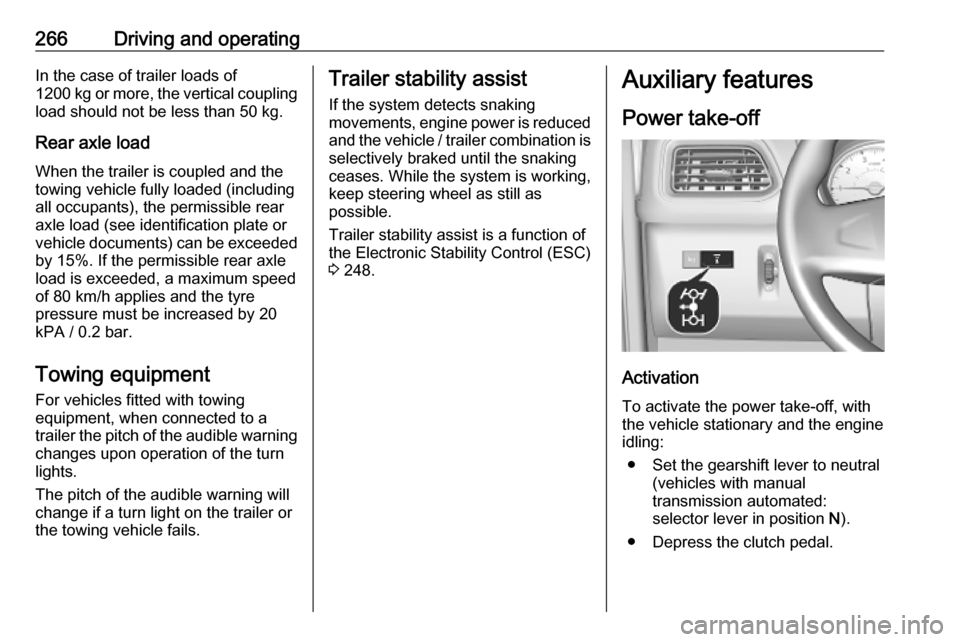
266Driving and operatingIn the case of trailer loads of
1200 kg or more, the vertical coupling load should not be less than 50 kg.
Rear axle load When the trailer is coupled and the
towing vehicle fully loaded (including all occupants), the permissible rear
axle load (see identification plate or
vehicle documents) can be exceeded by 15%. If the permissible rear axle
load is exceeded, a maximum speed
of 80 km/h applies and the tyre
pressure must be increased by 20
kPA / 0.2 bar.
Towing equipment For vehicles fitted with towing
equipment, when connected to a
trailer the pitch of the audible warning
changes upon operation of the turn
lights.
The pitch of the audible warning will
change if a turn light on the trailer or
the towing vehicle fails.Trailer stability assist
If the system detects snaking
movements, engine power is reduced
and the vehicle / trailer combination is
selectively braked until the snaking
ceases. While the system is working,
keep steering wheel as still as
possible.
Trailer stability assist is a function of
the Electronic Stability Control (ESC)
3 248.Auxiliary features
Power take-off
Activation
To activate the power take-off, with
the vehicle stationary and the engine
idling:
● Set the gearshift lever to neutral (vehicles with manual
transmission automated:
selector lever in position N).
● Depress the clutch pedal.
Page 269 of 353
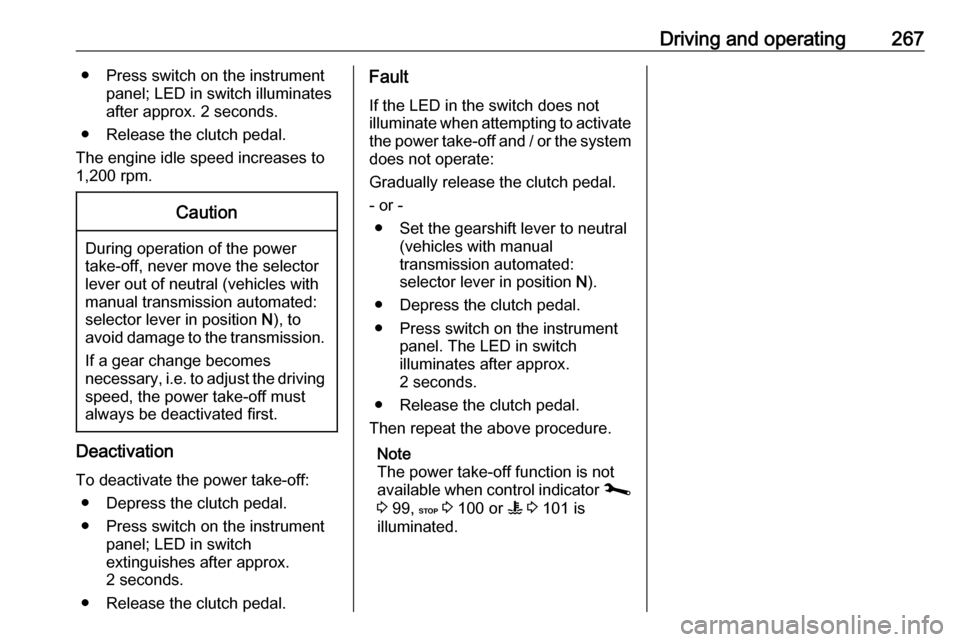
Driving and operating267● Press switch on the instrumentpanel; LED in switch illuminates
after approx. 2 seconds.
● Release the clutch pedal.
The engine idle speed increases to 1,200 rpm.Caution
During operation of the power
take-off, never move the selector
lever out of neutral (vehicles with
manual transmission automated:
selector lever in position N), to
avoid damage to the transmission.
If a gear change becomes
necessary, i.e. to adjust the driving
speed, the power take-off must always be deactivated first.
Deactivation
To deactivate the power take-off: ● Depress the clutch pedal.
● Press switch on the instrument panel; LED in switch
extinguishes after approx.
2 seconds.
● Release the clutch pedal.
Fault
If the LED in the switch does not
illuminate when attempting to activate the power take-off and / or the system
does not operate:
Gradually release the clutch pedal.
- or - ● Set the gearshift lever to neutral (vehicles with manual
transmission automated:
selector lever in position N).
● Depress the clutch pedal.
● Press switch on the instrument panel. The LED in switch
illuminates after approx.
2 seconds.
● Release the clutch pedal.
Then repeat the above procedure.
Note
The power take-off function is not
available when control indicator j
3 99, C 3 100 or W 3 101 is
illuminated.
Page 270 of 353

268Vehicle careVehicle careGeneral Information...................269
Accessories and vehicle modifications .......................... 269
Vehicle storage ........................269
End-of-life vehicle recovery .....270
Vehicle checks ........................... 270
Performing work ......................270
Bonnet ..................................... 270
Engine oil ................................. 271
Engine coolant ......................... 272
Power steering fluid .................273
Washer fluid ............................ 273
Brakes ..................................... 274
Brake fluid ............................... 274
Vehicle battery ......................... 274
Diesel fuel system bleeding .....276
Wiper blade replacement ........277
Bulb replacement .......................277
Headlights ............................... 278
Front fog lights ......................... 279
Front turn lights .......................279
Tail lights ................................. 280
Side turn lights ......................... 282
Centre high-mounted brake light ......................................... 282Number plate light...................283
Interior lights ............................ 284
Instrument panel illumination ...285
Electrical system ........................285
Fuses ....................................... 285
Engine compartment fuse box . 286
Instrument panel fuse box .......287
Load compartment fuse box ....288
Vehicle tools .............................. 290
Tools ........................................ 290
Wheels and tyres .......................291
Tyres ....................................... 291
Winter tyres ............................. 291
Tyre designations ....................291
Tyre pressure .......................... 291
Tyre pressure monitoring system .................................... 292
Tread depth ............................. 294
Changing tyre and wheel size . 295
Wheel covers ........................... 295
Tyre chains .............................. 295
Tyre repair kit .......................... 296
Wheel changing .......................299
Spare wheel ............................ 301
Jump starting ............................. 304
Towing ....................................... 306
Towing the vehicle ...................306
Towing another vehicle ...........307Appearance care .......................308
Exterior care ............................ 308
Interior care ............................. 310